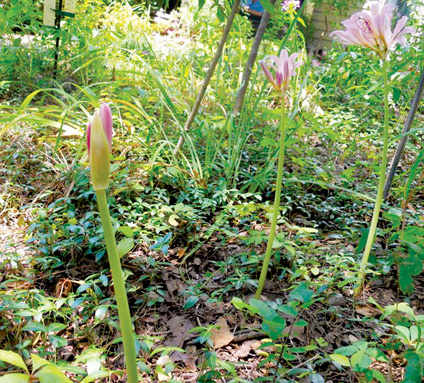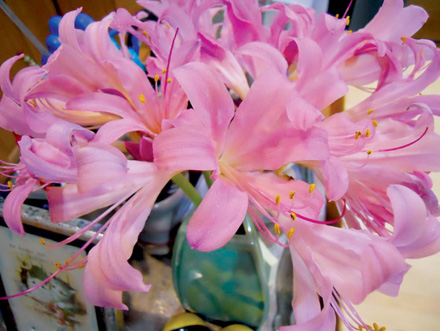Surprise Lilies

Several friends have told me they are a bit worried this year. Their surprise lilies, Lycoris squamigera, have popped up earlier than usual, they said, starting to bloom mid-July as opposed to early August. Is this one of those signs that winter will be earlier than usual?
Also called Resurrection lilies, mine started to pop up mid-July but, as I told them, the plant name suggests trying to time when these perennials bloom is probably not a good idea. After all, it’s supposed to be unexpected, isn’t it?
According to the Missouri Botanical Garden, plants in the genus Lycoris are sometimes commonly called resurrection flower, surprise lily or magic lily because the leaves disappear in summer with the flower spikes seemingly rising from the dead in late summer.
And while I am on the background of this delightful plant family, the genus name Lycoris is in honor of Mark Anthony’s mistress, and it wasn’t Cleopatra.
Surprise lilies are north American cousins to the Amaryllis we tend to see for sale around Christmas. The Christmas Amaryllis won’t survive our Midwest winters but surprise lilies are perennials in our USDA zone 5b growing area.
Surprise lily leaves appear in spring, collecting energy through those leaves and storing it in the below ground bulbs, then turning the leaves yellow and dying off. Then mid-summer, seemingly all of a sudden, a green stalk with buds at the top appear, heralding the arrival of what some people call the “naked ladies.”
The pink aromatic flowers last several days as cut flowers. The green stems will curl up at the bottom of a flower vase, forming an interesting artistic pattern all of their own.
Surprise lilies have been a popular landscaping addition for a number of decades in the Midwest and sometimes mark abandoned homesteads.
If you have surprise lilies in your garden, or are given bulbs to plant, these are relatively low maintenance.
Surprise lily bulbs should be separated every 5 years or so or they will grow too thick to bloom.
The best time to move surprise lily bulbs is right after they bloom. I have successfully moved surprise lilies as the green leaves were dying off mid-spring. Regardless of when you dig them up, start a good five inches from the edge of where you think the bulbs are so you don’t cut into the bulbs.
If the ground is dry, wet it down first before digging up the bulbs to minimize damage to roots.
Transplant to an area with room to grow. I mix compost and some aged mulch into the soil to help the bulbs get a good start once they are ready to grow.
I try to plant them where I will remember they are located so I am not digging into them later thinking this is a free spot to plant something else.
Intersperse surprise lilies with pink phlox and plant them behind daylilies and iris, which provide the plants some cover as they bloom.
Charlotte Ekker Wiggins is a beekeeper, gardener and sometimes cook. Published by El Dorado Springs Sun once in print and online with author’s permission. Copyright 2017, all rights reserved. This column may not be reprinted, republished or otherwise distributed without author’s permission. Contact Charlotte at gardeningcharlotte at gmail dot com.

NOTHING MUCH AT FIRST – Surprise lilies start out as a little bud on a stem, left, and end up as blooming flowers, right, still on leafless stems, right.
 PRETTY AS A PICTURE – Surprise lilies are wonderful cut flowers, adding a lovely aroma to any room. (Photos by Charlotte Ekker Wiggins).
PRETTY AS A PICTURE – Surprise lilies are wonderful cut flowers, adding a lovely aroma to any room. (Photos by Charlotte Ekker Wiggins).



Facebook Comments